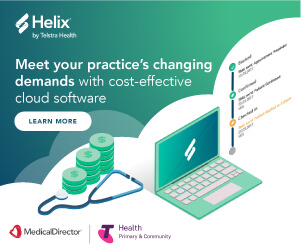How wearables will revolutionise healthcare
With the rise of health and fitness apps, smartwatches and wearables, ‘digital wellness’ is continuing to play a bigger part in our everyday lives. And with Apple and Google pushing their vision of wearable computing into the sector, the question now is, how will this new digital age of wellness impact healthcare?
“Before the wellness digital age, focusing on our personal, everyday ‘wellness’ offline, meant a general ad hoc tracking of simple data points like our weight, blood pressure, fitness and diet,” MedicalDirector’s CEO, Matt Bardsley, said. “If illness or injury hit, we’d be able to share this information with our healthcare provider, but usually in a relatively rough, unstructured way.”
Now, the proliferation of digital wellness devices and apps has signalled a new era in more individuals closely tracking their fitness and health than ever before. In fact, a recent report from Flurry Analytics, found health and fitness app usage has become increasingly popular, growing over 330% in just 3 years.
Interestingly, the report also showed significant increase in engagement with these apps, with three quarters of active users opening their health and fitness app at least twice a week, and over a quarter of users accessing their fitness apps over 10 times a week.
Wellness data empowering the patients
According to Bardsley, as a result of this increased wellness digital usage, individual users now have a wealth of data on their own wellbeing at their fingertips, making them far more empowered and equipped to track and monitor their own health and to some extent, even self-diagnose.
“Technology is now not only giving people incentive to become more deeply involved and interested in their own health, but they can easily share these data sets with their health practitioners in a far more accurate and structured way,” he added.
MedicalDirector’s CTO, David Higgins, agreed. He wrote in his latest feature for PC World that, as more complex apps emerge, they are set to give patients even greater responsibility for their own well-being, and provide a higher level of patient comfort, without compromising the efficiency of an already over-burdened health system.
“Health data can be uploaded to patients’ smartphones and shared in real-time with their relevant care providers, for faster diagnosis and treatment,” he said.
Detecting health conditions
Leveraging data and insights from ‘wellness wearables’ can also aid diagnosis and treatment in healthcare. In fact, a recent study revealed wearable devices like Apple Watch and FitBit are already able to gather sophisticate data to enable serious detection of health conditions such as hypertension and sleep apnoea.
“Our deep neural network (DNN) demonstrates surprisingly good prediction of hypertension and sleep apnoea given that its only inputs are heart rate and step count,” the report stated. “Whether such DNNs can provide durable and portable predictions for these conditions in other study samples is worth pursuing.”
Benefits of automation
According to GP and MedicalDirector’s Chief Clinical Advisor, Dr Charlotte Middelton, wearables also have the benefit of automating often time-consuming and manual processes, to allow doctors to make more informed diagnosis and treatment plans.
“Wearables are already tracking data such as heart rate, blood sugar levels, blood pressure, and other vital statistics, taking the pressure off the patient to manually complete these analyses. Doctors and nurses can then download the readings for a complete picture of a patient’s health,” she said in a feature published on PC World. “Heavy patient loads for doctors and a shortage of medical staff in remote areas can limit the amount of in-clinic or hospital visits for patients.”
“However through the use of wearables, medical personnel can conduct remote patient monitoring. Similarly, in the event of a health scare or crisis, patients can quickly send data to their medical team for analysis.”
Already, we are seeing great inroads in wellness wearables, such as ihealth’s innovative blood pressure, weight management and diabetes monitoring wearables and oximeters.
Meanwhile Propell Health, the Australian partner of the company, are driving their easy-to-use and award-winning wearables in the local market, making it simple for consumers to accurately measure, track and share a full range of health vitals.
Is healthcare keeping up with digital change?
We’re on the cusp of a new era of human-machine partnership, and healthcare is prepared for the change, a new report found.
Dell Technologies recently teamed-up with Institute for the Future (IFTF) and 20 experts to release the Vanson Bourne Realizing 2030 survey, which asked 3800 business leaders from around the world to forecast how emerging technologies will reshape how we live and work by 2030.
Interestingly, when it comes to the fast uptake of consumer wellness wearables, the report found over a half of business leaders across Asia-Pacific and Japan see this as motivating people to taking better care of themselves by leveraging the potential of wearable devices.
Meanwhile, the potential for healthcare professionals to manage and share the same data patients have on their wearable devices is still being underutilised.
“Both individuals and organisations are grappling with the digital and workforce transformations underway today,” The report concluded. “If we start to approach the next decade as one in which partnerships between humans and machines transcend our limitations and build on our strengths, we can begin to create a more favourable future for everyone.”









